''Tangara'' (genus)
| Tangara | |
|---|---|
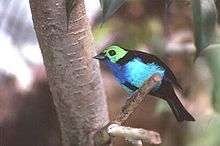 | |
| Paradise tanager, Tangara chilensis | |
| Scientific classification | |
| Kingdom: | Animalia |
| Phylum: | Chordata |
| Class: | Aves |
| Order: | Passeriformes |
| Family: | Thraupidae |
| Genus: | Tangara Brisson, 1760 |
| Species | |
|
About 50, see list | |
| Synonyms | |
| |
Tangara is a large genus of birds of the tanager family. It includes about 50 species, but as currently defined the genus is polyphyletic.[1] All are from the Neotropics, and while most are fairly widespread, some have small distributions and are threatened. They are fairly small, ranging in size from 11.5–15 centimetres (4.5–5.9 in). This genus includes some of the most spectacularly colored birds of the world.
Taxonomy and systematics
The genus Tangara was introduced by the French zoologist Mathurin Jacques Brisson in 1760.[2] The name means "dancer" in the extinct Tupi language.[3]
Extant species
Forty-nine extant species are recognized:[4]
| Image | Common Name | Scientific name | Distribution |
|---|---|---|---|
.jpg) | Plain-colored tanager | Tangara inornata | Colombia, Costa Rica, and Panama |
| Cabanis's tanager | Tangara cabanisi | western Guatemala and southern Chiapas, Mexico | |
| Grey-and-gold tanager | Tangara palmeri | Colombia, Ecuador, and Panama | |
 | Turquoise tanager | Tangara mexicana | Trinidad, Colombia and Venezuela south to Bolivia and much of Brazil |
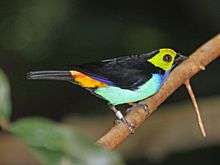 | Paradise tanager | Tangara chilensis | western and northern Amazon Basin in South America, it occurs in Venezuela, Peru, Colombia, Ecuador, Bolivia, Brazil and the Guianas |
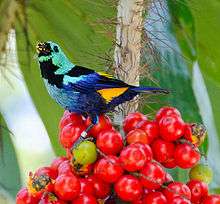 | Seven-colored tanager | Tangara fastuosa | north-eastern Brazil |
 | Green-headed tanager | Tangara seledon | south-eastern Brazil, far eastern Paraguay, and far north-eastern Argentina |
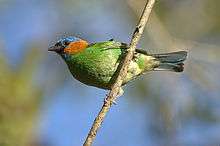 | Red-necked tanager | Tangara cyanocephala | Argentina, Brazil, and Paraguay |
.jpg) | Brassy-breasted tanager | Tangara desmaresti | Brazil |
 | Gilt-edged tanager | Tangara cyanoventris | Brazil |
| Blue-whiskered tanager | Tangara johannae | Colombia and Ecuador. | |
 | Green-and-gold tanager | Tangara schrankii | eastern Venezuela, Colombia, Ecuador, Peru, central Bolivia, and northwestern Brazil |
.jpg) | Emerald tanager | Tangara florida | Colombia, Costa Rica, Ecuador, and Panama |
.jpg) | Golden tanager | Tangara arthus | Andes (from Bolivia and northwards) and Venezuelan Coastal Range in north-western South America |
.jpg) | Silver-throated tanager | Tangara icterocephala | Costa Rica, through Panama and western Colombia, to western Ecuador. |
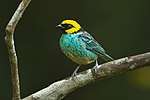 | Saffron-crowned tanager | Tangara xanthocephala | northern Andes of Bolivia, Colombia, Ecuador, Peru, and Venezuela. |
.jpg) | Golden-eared tanager | Tangara chrysotis | eastern Andes of Bolivia, Colombia, Ecuador and Peru |
.jpg) | Flame-faced tanager | Tangara parzudakii | eastern Andes of Colombia, Ecuador, Peru and Venezuela |
| Yellow-bellied tanager | Tangara xanthogastra | Bolivia, Brasil, Colombia, Ecuador, Guyana, Perú, and Venezuela | |
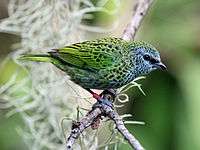 | Spotted tanager | Tangara punctata | Bolivia, Brazil, Ecuador, French Guiana, Guyana, Peru, Suriname, and Venezuela |
.jpg) | Speckled tanager | Tangara guttata | Costa Rica, Panama, Trinidad, Venezuela, Colombia, Guyana, Suriname and the extreme north of Brazil |
| Dotted tanager | Tangara varia | Brazil, French Guiana, Suriname, and Venezuela | |
.jpg) | Rufous-throated tanager | Tangara rufigula | Colombia and Ecuador. |
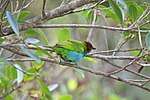 | Bay-headed tanager | Tangara gyrola | Ecuador, Bolivia and southern Brazil, and on Trinidad |
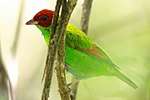 | Rufous-winged tanager | Tangara lavinia | Colombia, Costa Rica, Ecuador, Honduras, Nicaragua, and Panama |
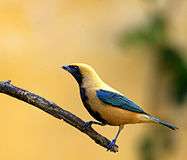 | Burnished-buff tanager | Tangara cayana | northern Guianas, most of Venezuela and east-central Colombia; also near the Amazon River outlet in Brazil, as well as most of the east of that country, Paraguay and northeast Argentina |
 | Lesser Antillean tanager | Tangara cucullata | Grenada and Saint Vincent |
| Black-backed tanager | Tangara peruviana | south-eastern Brazil | |
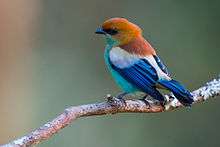 | Chestnut-backed tanager | Tangara preciosa | southern Brazil, north-eastern Argentina, eastern Paraguay, and Uruguay. |
.jpg) | Scrub tanager | Tangara vitriolina | Colombia and Ecuador |
| Green-capped tanager | Tangara meyerdeschauenseei | Puno, Peru, and La Paz, Bolivia | |
| Rufous-cheeked tanager | Tangara rufigenis | Venezuela | |
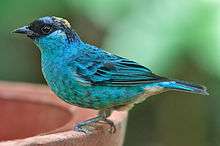 | Golden-naped tanager | Tangara ruficervix | Bolivia, Colombia, Ecuador, and Peru. |
| Metallic-green tanager | Tangara labradorides | Colombia, Ecuador, and Peru | |
| Blue-browed tanager | Tangara cyanotis | Bolivia, Colombia, Ecuador, and Peru. | |
_(16212611057).jpg) | Blue-necked tanager | Tangara cyanicollis | Bolivia, Brazil, Colombia, Ecuador, Peru, and Venezuela. |
.jpg) | Golden-hooded tanager | Tangara larvata | southern Mexico south to western Ecuador |
| Masked tanager | Tangara nigrocincta | Bolivia, Brazil, Colombia, Ecuador, Guyana, Peru, and Venezuela. | |
.jpg) | Spangle-cheeked tanager | Tangara dowii | Costa Rica and western Panama |
| Green-naped tanager | Tangara fucosa | Colombia and Panama | |
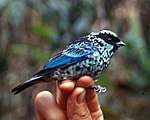 | Beryl-spangled tanager | Tangara nigroviridis | Colombia through Ecuador and Peru to Bolivia |
 | Blue-and-black tanager | Tangara vassorii | Bolivia, Colombia, Ecuador, Peru and Venezuela |
_-_Hembra_(14183051769).jpg) | Black-capped tanager | Tangara heinei | Colombia, Venezuela and Ecuador. |
| Sira tanager | Tangara phillipsi | Peru | |
| Silver-backed tanager | Tangara viridicollis | southern Ecuador, Peru, and Bolivia | |
| Straw-backed tanager | Tangara argyrofenges | Ecuador, Peru and Bolivia | |
.jpg) | Black-headed tanager | Tangara cyanoptera | South America (Andes of northeastern Colombia, Venezuelan Coastal Range and tepuis of southern Venezuela). |
.jpg) | Opal-rumped tanager | Tangara velia | Amazon and Atlantic Forest of South America |
| Opal-crowned tanager | Tangara callophrys | southern Colombia, eastern Ecuador and Peru and a region of northwestern Bolivia; for Brazil | |
Former species
Formerly, some authorities also considered the following species (or subspecies) as species within the genus Tangara:
- South Island piopio (as Tanagra capensis)[5]
Distribution and habitat
These tanagers are mainly found high in forest canopies, but some occupy more open habitat. They are found at all elevations below tree line but are most diverse in the Andean subtropical and foothill forests of Colombia, Ecuador and Peru.
Behaviour and ecology
Breeding
The female builds a usually well concealed cup nest and lays two brown- or lilac-speckled white eggs. These hatch in 13–14 days and the chicks fledge in a further 15–16 days. The male and female feed the nestlings on insects and fruit, and may be assisted by helpers.
Food and feeding
Tangara tanagers pick insects from leaves, or sometimes in flight, but fruit is a major dietary item, accounting for 53-86% of food items in those species which have been studied.
References
- ↑ Sedano, R. E., & BURNS, K. J. (2010). Are the Northern Andes a species pump for Neotropical birds? Phylogenetics and biogeography of a clade of Neotropical tanagers (Aves: Thraupini). Journal of Biogeography 37: 325–343.
- ↑ Brisson, Mathurin Jacques (1760). Ornithologie, ou, Méthode contenant la division des oiseaux en ordres, sections, genres, especes & leurs variétés (in French and Latin). Paris: Jean-Baptiste Bauche. Volume 1 p. 36 and Volume 3 p. 3.
- ↑ Jobling, J.A. (2018). del Hoyo, J.; Elliott, A.; Sargatal, J.; Christie, D.A.; de Juana, E., eds. "Key to Scientific Names in Ornithology". Handbook of the Birds of the World Alive. Lynx Edicions. Retrieved 2 April 2018.
- ↑ Gill, Frank; Donsker, David, eds. (2018). "Tanagers and allies". World Bird List Version 8.1. International Ornithologists' Union. Retrieved 2 April 2018.
- ↑ "Turnagra capensis - Avibase". avibase.bsc-eoc.org. Retrieved 2017-02-20.
Further reading
- ffrench, Richard (1991). A Guide to the Birds of Trinidad and Tobago (2nd ed.). Comstock Publishing. ISBN 0-8014-9792-2. .
- Hilty, Steven L (2003). Birds of Venezuela. London: Christopher Helm. ISBN 0-7136-6418-5. .
- Morton, Isler & Isler, Tanagers ISBN 0-7136-5116-4.
- Stiles and Skutch, A guide to the birds of Costa Rica ISBN 0-8014-9600-4.